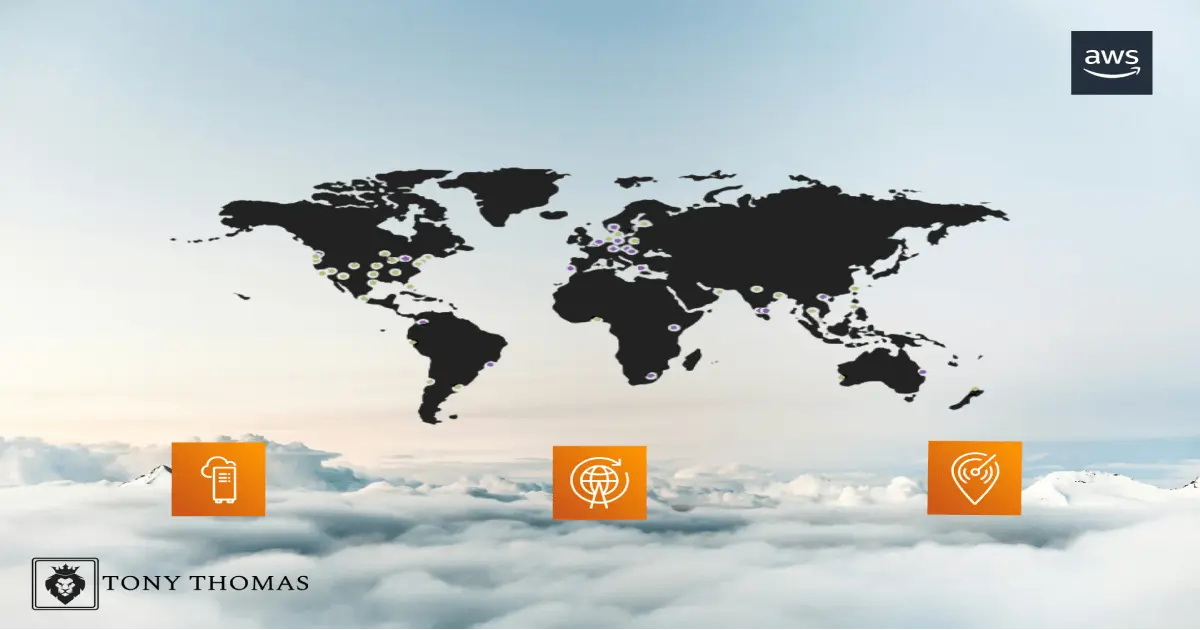Are you curious about the vast web that powers Amazon Web Services (AWS)? In this article, we explore AWS’s global infrastructure, covering regions, availability zones, points of presence, regional edge caches, local zones, wavelength zones, and outposts.
Table Of Content
- AWS Regions: The Foundation of Global Infrastructure
- Availability Zones: Building High Availability into Every Region
- Points of Presence (PoPs): Bringing AWS Closer to Users
- Regional Edge Caches: Reducing Latency for Frequently Accessed Content
- Local Zones: Meeting Low-Latency Needs in Specific Cities
- Wavelength Zones: Powering Ultra-Low Latency at the Mobile Network Edge
- AWS Outposts: Bringing AWS to Your Data Center
- Choosing the Right AWS Infrastructure for Your Needs
- Conclusion: Unlocking the Power of AWS Infrastructure
AWS leads the cloud computing space. Understanding its infrastructure helps businesses and developers make the most of its services. We’ll begin by examining regions and availability zones to see how AWS ensures high availability and fault tolerance. Then, we’ll look at how AWS improves performance with connectivity hubs like PoPs and edge caches. Finally, we’ll explore AWS extensions such as local zones, wavelength zones, and Outposts that bring cloud services even closer to users.
Let’s break down each component of this global network.
AWS Regions: The Foundation of Global Infrastructure
AWS operates multiple regions across the globe. Each region is a separate geographic area with its own infrastructure and network. These regions are designed to deliver low latency and fault tolerance.
Inside each region, AWS offers core services like compute, storage, and networking. By selecting the right region, users can improve performance and meet compliance needs based on geography.
Each region functions independently. So if one region experiences an issue, others remain unaffected. Currently, AWS runs 25 regions worldwide, including popular ones like:
- US East (N. Virginia)
- EU (Ireland)
- Asia Pacific (Singapore)
- South America (São Paulo)
In short, regions allow AWS to serve users locally while meeting data sovereignty, performance, and regulatory requirements.
Availability Zones: Building High Availability into Every Region
Each AWS region contains multiple availability zones (AZs). These zones are physically separate data centers with independent power, cooling, and networking. They are interconnected using low-latency links.
The main purpose of availability zones is to improve fault tolerance. If one zone fails due to an outage or disaster, applications running in other zones continue without interruption.
When you build applications on AWS, it’s best to distribute resources across multiple AZs. Tools like Elastic Load Balancing and Auto Scaling help you manage traffic and handle spikes efficiently.
In essence, AZs ensure your apps stay online, even when unexpected issues occur in one part of the infrastructure.
Points of Presence (PoPs): Bringing AWS Closer to Users
AWS operates points of presence (PoPs) worldwide. These are edge locations where user requests enter AWS’s global network.
When a user accesses an AWS-hosted service, the request goes to the nearest PoP. This reduces latency and improves performance. AWS routes the request through its high-speed backbone to the appropriate region and availability zone.
PoPs also support AWS services like Amazon CloudFront, caching content and reducing the load on origin servers. This setup is crucial for global applications with distributed users.
With PoPs, businesses can deliver faster, more reliable services and enhance the user experience on a global scale.
Regional Edge Caches: Reducing Latency for Frequently Accessed Content
AWS uses regional edge caches to improve performance further. These servers store content closer to users, but they sit between PoPs and origin servers.
When a user requests static or rarely changing content (like images or videos), the cache serves it directly. This reduces load times and minimizes the need to reach the origin server.
Edge caches are part of Amazon CloudFront, AWS’s content delivery network. They’re particularly useful for media-heavy or high-traffic applications.
Using regional edge caches helps businesses speed up content delivery and reduce infrastructure load.
Local Zones: Meeting Low-Latency Needs in Specific Cities
AWS introduced local zones to serve users in specific cities with extremely low-latency requirements.
A local zone extends an AWS region by placing compute and storage resources closer to users in a metropolitan area. These zones are ideal for latency-sensitive workloads like gaming, real-time streaming, and machine learning.
Each local zone connects back to its parent region through a high-speed link. This setup allows applications to perform local processing while still using central AWS services.
Currently, local zones are available in cities like Los Angeles and the San Francisco Bay Area. AWS plans to expand them as demand grows.
For apps that need sub-10-millisecond response times, local zones offer a solid solution.
Wavelength Zones: Powering Ultra-Low Latency at the Mobile Network Edge
Wavelength Zones bring AWS infrastructure to the edge of mobile networks. Designed for ultra-low-latency apps, they are deployed in partnership with telecom providers.
By placing AWS services inside telecom data centers, Wavelength Zones allow traffic to skip traditional internet paths. This setup is ideal for applications like augmented reality, gaming, and real-time video processing.
AWS currently offers Wavelength Zones in cities like Atlanta, Dallas, Boston, and San Francisco. These zones will likely expand as edge computing becomes more widespread.
If your app needs real-time responsiveness over 5G, Wavelength Zones provide a powerful edge-computing environment.
AWS Outposts: Bringing AWS to Your Data Center
Not all businesses can move everything to the cloud. For cases where on-premises infrastructure is still required, AWS offers Outposts.
An Outpost is a fully managed rack that runs AWS services locally, in your own data center. You get the same APIs, tools, and services available in the cloud, but with data and workloads staying on-premises.
Outposts are perfect for workloads needing low-latency access to on-site systems or those with strict compliance rules.
By using Outposts, businesses can build hybrid environments that combine local control with cloud-scale flexibility.
Choosing the Right AWS Infrastructure for Your Needs
With so many infrastructure options, choosing the right mix depends on your business goals. Here are some key considerations:
- Need low latency for city-specific users? Use Local Zones.
- Building real-time apps on 5G? Go with Wavelength Zones.
- Managing hybrid infrastructure? Outposts fit the bill.
- Looking to serve global users efficiently? Regions, AZs, and PoPs are essential.
AWS provides tools like the Well-Architected Framework to guide you in making the best architectural decisions.
By aligning infrastructure choices with your workload needs, you can improve performance, lower costs, and ensure compliance.
Conclusion: Unlocking the Power of AWS Infrastructure
AWS’s global infrastructure is vast, but each component serves a clear purpose. From the reliability of regions and availability zones to the performance gains of PoPs, caches, and edge zones, AWS helps businesses build resilient, low-latency, high-performance applications.
As AWS continues to expand, new options will help businesses deliver faster and better services to customers around the world.
Whether you’re a startup or an enterprise, understanding AWS’s infrastructure helps you make smarter decisions—and ultimately, deliver better outcomes.







